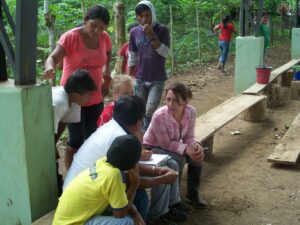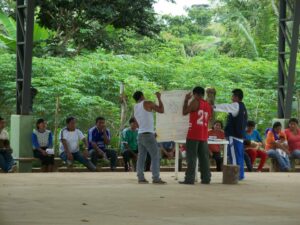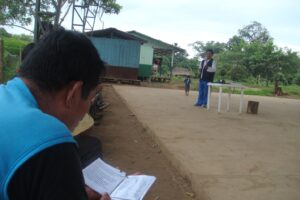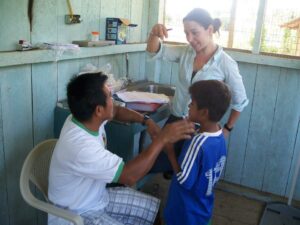Engaged Anthropology Grant: Felicia Madimenos and “Engaging Shuar Communities Through Collaborative Health Education: Enhancing Participant Agency in Indigenous Health Research”

Felicia Madimenos is Assistant Professor of Anthropology at Queens College, City University of New York. In 2009, while a doctoral candidate at the University of Oregon, she received a Dissertation Fieldwork Grant to aid research on ‘Lifestyle and Reproductive Effects on Bone Mineral Density in an Ecuadorian Forager-Horticulturalist Population,’ supervised by Dr. James Snodgrass. This year, she was awarded the Engaged Anthropology Grant to follow up her work with Shuar communities and conduct a series of workshops, presentations and family days to disseminate information regarding health issues in the community.
In a remote rural Shuar village located along Rio Morona, an elderly Shuar man, sits in a wheelchair as his wife pushes him along the rocky, unpaved road. As he makes his way closer to the now-defunct clinic space, my colleagues and I can see that his right leg is missing just below the hip. Along with his wife, he is accompanied by his eldest daughter, son-in-law and grandchildren. Because of a community-wide meeting we held days earlier, the family was aware that Shuar nurses, accompanied by American anthropologists, were staying in the village and were providing information about basic health issues.
Clearly, there was nothing any of us could do for his leg although initially, he refrained from mentioning his leg at all; he merely wanted information about his general health and well-being. He explained that two years earlier he was diagnosed with diabetes by a doctor from a clinic located three-hours up the road, and the doctor stated that they needed to amputate his leg due to his condition. While plausible, something seemed amiss with the story. As we continued to talk, his son-in-law, feeling increasingly comfortable to talk openly, narrated in detail the events leading to the amputation of his father-in law’s leg. In short, his father in-law had stepped on a rusty nail while working in his garden and it became seriously infected, which eventually resulted in a trip to the doctor. “Can stepping on a nail give you diabetes?,” the son-in-law asked. “No,” we responded firmly, although we wondered whether diabetes exacerbated the infection, or whether there was miscommunication of some kind. As it turned out, the man’s fasting glucose levels were optimal, and based on data we had for him from years earlier, there was no indication that insulin-resistance was ever an issue. Further, the man claimed to have never taken medication for diabetes but accepted the fact that his leg was removed because of it. This type of miscommunication, that stepping on a nail could cause diabetes which warranted an amputation, while one of the more extreme examples, reflects a common theme in my line of research.

This interaction highlighted the critical importance of providing both contextual information and clarifying misinformation about the causes and prevention of illness and disease, and stressed the need to bridge communication barriers. Explanations by medical doctors who diagnose/treat disease and anthropologists who study health are simply not enough because this information gets filtered, forgotten, and lost after people leave the clinic to continue on with their daily lives. Health interviews with Shuar reveal that most people are unclear about what information is relevant to a given condition, and so when given a chance they may often provide an overwhelming amount of information about multiple conditions they have experienced at different times, on the reasonable assumption that it is all pertinent. However, health care workers are busy, and discussions with Shuar reveal that most think many clinicians do not listen to them, making them more inclined to present their most immediate symptoms with no additional information. It goes without saying that for our participants to retain a sense of agency in matters regarding their own health, and for health information to be useful and remain effective over the long-term, this knowledge must be individualized and translated into a tangible, transparent, and accessible form, with ample time for active ongoing individual dialog between participant and information provider.
The funds provided by the Engaged Anthropology Grant allowed me to reconsider how my colleagues and I conduct health research in a non-clinical, non-Western setting and reinforced the importance of the process of disseminating health information. Within the first few days of arriving in this remote village where we had worked during an earlier field season, we organized a community-wide meeting where we re-introduced ourselves and our research. This opportunity provided an ideal platform to field questions and address community concerns and, moreover, it stressed the need for a more personalized interaction with community members. In order to maximize our engagement with participants both old and new, we scheduled family health days where entire families would meet with the team of nurses and anthropologists to ask health-related questions, receive follow-up assessments and updated individualized information on health and prevention. When necessary, we would provide first aid or pass information to local health care providers for diagnosis and/or to dispense necessary medicines.

Prior to our arrival, I designed educational packets, adapting content from public health resources, and synthesized and condensed health information. Whenever possible, I emphasized images rather than written text. Each packet addressed health issues that we commonly encountered in past research and that Shuar participants most frequently report experiencing including anemia, dehydration, urinary tract infections, gastrointestinal issues, and chronic health problems that are increasing in prevalence (e.g., diabetes, cardiovascular disease, hypertension). Family health days provided an opportunity to personalize explanations regarding health issues and allowed us to distribute these materials to Shuar participants and discuss them individually and extensively. Some families hovered over the educational materials while children giggled at the images, and others asked for additional copies to bring to extended family and friends. Many were visibly excited to take a tangible reminder of this meeting home. “This is good,” says Carlos, a middle-aged Shuar man who came with his wife and eight children. “After you leave, we have this to remind us of the things you told us.” In addition to educational materials, based on consultation with community leaders, a Ministry of Health nurse, and local health promoter, our team donated basic over-the-counter medicines readily available in any Ecuadorian pharmacy, including antibiotics and parasite treatment kits, to be distributed as necessary after we departed.
Over the next few weeks, we participated in a community-wide workshop on family planning, initiated by the area’s Ministry of Health and led by our colleague, a local Shuar community health promoter and nurse. It is not uncommon for Shuar families, particularly in the more remote regions, to have upwards of 10-11 children. In a region where new government education centralization plans will position the nearest primary school two-hours away, where children need money for travel and school supplies, and where a childhood visit to the doctor requires a six-hour walk or two-hour canoe trip, information on family planning is increasingly of critical importance. However, it remains a very sensitive subject. Many participants in the past have shared with us the tribulations of having such large families and while the Ecuadorian government provides gratis family planning services, few Shuar, especially in these remote regions, have immediate and regular access to, or even information on contraception. This educational workshop was essential to establish a comfortable discourse on family planning and to discuss what options are available to Shuar in order to be active agents in matters concerning their own health and bodies. The presentation evoked the notion that larger, overarching factors trickle down and interact to shape individual health and well-being. Feeling like one has control over his/her surroundings, whether by being armed with knowledge that one has choices regarding the size of the family unit, or recognizing that modifiable aspects of lifestyle can shape how one feels from day to day are significant, and often overlooked forces that intimately influence personal health. Whether Shuar who attended this workshop felt this information was useful or not is unclear but we did not observe evidence of tension; participants seemed to be engaged in the discussion, and generally had a positive response. As health researchers, we knew that many participants had privately requested information on birth control, but this meeting appeared to go far towards normalizing an open discussion of these delicate issues and in creating awareness that people’s own health and bodies are in their command.

Lack of information, misinformation, and miscommunication regarding the causes, treatments, and preventative strategies for common and increasingly prevalent health issues warrants action on the part of the health researcher to stave off potential graver health problems in the future. For example, in another community closer to town where we presented health information with a local nurse, it was commonly believed that there was medication that could “cure” diabetes, despite the fact that three elderly people in the town had diabetes and were taking medication to control it. In discussing diet and prevention, it became apparent that one young woman was very knowledgeable about these issues, and yet it was only in the context of this presentation that this came to light, and we could reinforce to others that she was an excellent available resource for information on the topic. In short then, one remedy is for researchers to develop opportunities that empower communities by making accessible the knowledge and information necessary for community members to participate in, and affect informed decisions about their health, but moreover to approach this within the context of resources reasonably available to the participants. It is clear from my experience that for this approach to be successful, collaborations with local colleagues are essential, and individual as well as community-level dialogue is integral.